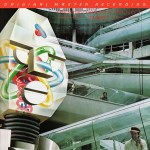More Breakthrough Pressing Discoveries
Many years ago, right around 2015 I believe, we played a copy with all the presence, all the richness, all the size and all the energy we ever hoped to hear from a top quality pressing of Dark Side of the Moon.
It did it ALL and then some.
The raging guitar solos (there are three of them) on Money seemed to somehow expand the system itself, making it bigger and more powerful than I had ever heard.
Even our best copies of Blood Sweat and Tears have never managed to create such a huge space with that kind of raw power. This copy broke through all the barriers, taking the system to an entirely new level of sound.
Take the clocks on Time. There are whirring mechanisms that can be heard deep in the soundstage on this copy that I’ve never heard as clearly before. On most copies you can’t even tell they are there. Talk about transparency — I bet you’ve NEVER heard so many chimes so clearly and cleanly, with such little distortion on this track.
One thing that separates the best copies from the merely good ones is super-low-distortion, extended high frequencies. How some copies manage to correctly capture the overtones of all the clocks, while others, often with the same stamper numbers, do no more than hint at them, is something no one can explain. But the records do not lie. Believe your own two ears. If you hear it, it’s there. When you don’t — the reason we do shootouts in a nutshell — it’s not.
The best sounding parts of this record are nothing less than ASTONISHING. Money is the best example I can think of for side two. When you hear the sax player rip into his solo as Money gets rockin’, it’s almost SCARY! He’s blowin’ his brains out in a way that has never, in my experience anyway, been captured on a piece of plastic. After hearing this copy, I remembered exactly why we felt this album must rank as one of the five best Rock Demo Discs to demonstrate the superiority of analog. There is no CD, and there will never be a CD, that sounds like this.
In fact, when you play the other “good sounding” copies, you realize that the sound you hear is what would naturally be considered as good as this album could get. But now we know better. This pressing takes Dark Side to places you have never imagined it could go.
To say this is a sonic and musical masterpiece practically without equal in the history of the world is no overstatement. But you have to have a top copy for that statement to be true.
Our Previous Hot Stamper Commentary
Side One
A+++ and should absolutely BLOW YOUR MIND with its HUGE, three-dimensional soundfield. It’s got big-time energy, amazing presence, and wonderful clarity. The bottom end sounds phenomenal, with real weight to the bass. The overall sound is rich, sweet and warm. Listen to how clean and clear the female background vocalists sound on Time. The guitars have a meaty texture that really adds to the life force of this copy — it’s positively ELECTRIC.
Side Two
Side two is every bit as AMAZING! A+++ White Hot sound. The size of the stage on this side is beyond anything in our experience. Check out the incredible transparency and the silky highs, as well as the breathy vocals and tons of energy. Money on this copy will blow your mind. We had a copy with bigger bass than this one but it could not hold a candle to this one is any other way. This was an easy choice for Best Side Two Ever.








 If you like
If you like 